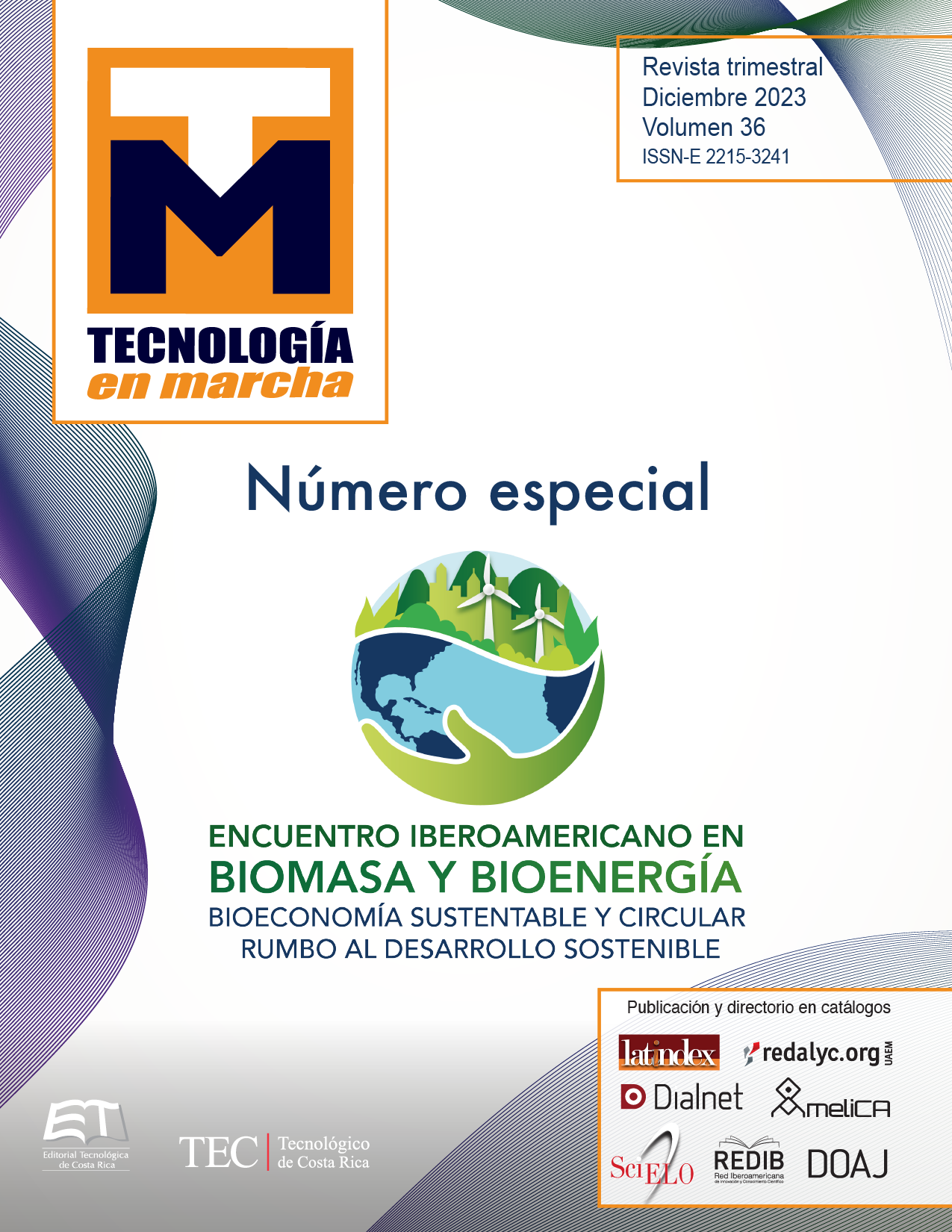Biomass and waste pyrolysis as a strategy for sustainable production and industrial symbiosis in the Community of Madrid (Spain)
Main Article Content
Abstract
Because of its versatility to produce a mixture of solid, liquid, and gaseous products in various quantities depending on operational factors, pyrolysis technology has attracted a lot of attention recently. Additionally, it opens up the prospect of increasing the materials’ energy density and transforming them into high-value products and biofuels.
In the current study, a variety of biomass wastes from the food industry and mechanical-biological treatment facilities were chosen to be treated with thermochemical pyrolysis. With particular focus on the bio-oil, the impact of the operating conditions on the yield and composition of the pyrolysis products was investigated. From waste from the brewing industry and discarded potato chips, a higher bio-oil yield is obtained. In addition, its lower ash content and higher calorific value contribute to improve the properties of bio-oil. On the other hand, the solid fraction predominates in the pyrolysis of urban solid wates. For this reason, chemical and textural analysis was used to characterize the resultant solid fraction, biochar. The biochar has undergone physical and chemical processing to produce adsorbents for carbon dioxide capture and possibly other applications.
Article Details

This work is licensed under a Creative Commons Attribution-NonCommercial-NoDerivatives 4.0 International License.
Los autores conservan los derechos de autor y ceden a la revista el derecho de la primera publicación y pueda editarlo, reproducirlo, distribuirlo, exhibirlo y comunicarlo en el país y en el extranjero mediante medios impresos y electrónicos. Asimismo, asumen el compromiso sobre cualquier litigio o reclamación relacionada con derechos de propiedad intelectual, exonerando de responsabilidad a la Editorial Tecnológica de Costa Rica. Además, se establece que los autores pueden realizar otros acuerdos contractuales independientes y adicionales para la distribución no exclusiva de la versión del artículo publicado en esta revista (p. ej., incluirlo en un repositorio institucional o publicarlo en un libro) siempre que indiquen claramente que el trabajo se publicó por primera vez en esta revista.
References
D. Czajczyńska, L. Anguilano, H. Ghazal, R. Krzyżyńska, A.J. Reynolds, N. Spencer and H. Jouhara, “Potential of pyrolysis processes in the waste management sector”, Thermal Science and Engineering Progress, vol. 3, Sept. 2017, pp. 171-197, doi: 10.1016/j.tsep.2017.06.003.
P. Shrivastava, A. Kumar, P. Tekasakul, S. S. Lam, and A. Palamanit, “Comparative investigation of yield and quality of bio-oil and biochar from pyrolysis of woody and non-woody biomasses,” Energies (Basel), vol. 14, no. 4, Feb. 2021, doi: 10.3390/en14041092
B. Grycová, I. Koutník, A. Pryszcz, “Pyrolysis process for the treatment of food waste”, Bioresource Technology, vol. 218, Oct. 2016, pp. 1203-1207, doi: 10.1016/j.biortech.2016.07.064
Y. S. Ho and G. Mckay, “Pseudo-second order model for sorption processes,” 1999.
O. Awogbemi, D.V. Kallon and A.O. Owoputi, “Biofuel Generation from Potato Peel Waste: Current State and Prospects”, Recycling, vol. 7, Ap. 2022, 23. doi: 10.3390/recycling7020023
Naibaho J and Korzeniowska M, “The variability of physico-chemical properties of brewery spent grain from 8 different breweries”, Heliyon, vol. 26;7(3), March 2021, e06583. doi: 10.1016/j.heliyon.2021.e06583.
M. N. Islam, S. B. Ratul, A. Sharmin, K. S. Rahman, M. Ashaduzzaman, and G. M. N. Uddin, “Comparison of calorific values and ash content for different woody biomass components of six mangrove species of Bangladesh Sundarbans,” Journal of the Indian Academy of Wood Science, vol. 16, no. 2, pp. 110–117, Dec. 2019, doi: 10.1007/s13196-019-00246-9.
A. Adamovics, R. Platace, I. Gulbe, and S. Ivanovs, “The content of carbon and hydrogen in grass biomass and its influence on heating value,” in Engineering for Rural Development, 2018, vol. 17, pp. 1277–1281. doi: 10.22616/ERDev2018.17.N014.
O. Ławińska, A. Korombel, and M. Zajemska, “Pyrolysis‐Based Municipal Solid Waste Management in Poland—SWOT Analysis,” Energies (Basel), vol. 15, no. 2, Jan. 2022, doi: 10.3390/en15020510.
L. M. Terry et al., “Bio-oil production from pyrolysis of oil palm biomass and the upgrading technologies: A review,” Carbon Resources Conversion, vol. 4. KeAi Publishing Communications Ltd., pp. 239–250, Jan. 01, 2021. doi: 10.1016/j.crcon.2021.10.002.
B. R. Albuquerque, S. A. 8. Heleno, M. B. P. P. Oliveira, L. Barros, and I. C. F. R. Ferreira, “Phenolic compounds: Current industrial applications, limitations and future challenges,” Food and Function, vol. 12, no. 1. Royal Society of Chemistry, pp. 14–29, Jan. 07, 2021. doi: 10.1039/d0fo02324h.
L. D. M. S. Borel, A. M. Reis Filho, T. P. Xavier, T. S. Lira, and M. A. S. Barrozo, “An investigation on the pyrolysis of the main residue of the brewing industry,” Biomass Bioenergy, vol. 140, Sep. 2020, doi: 10.1016/j.biombioe.2020.105698.
J. L. Zheng, Y. H. Zhu, M. Q. Zhu, G. T. Sun, and R. C. Sun, “Life-cycle assessment and techno-economic analysis of the utilization of bio-oil components for the production of three chemicals,” Green Chemistry, vol. 20, no. 14, pp. 3287–3301, 2018, doi: 10.1039/c8gc01181h.

